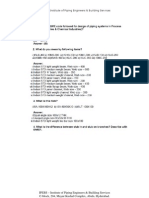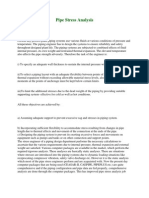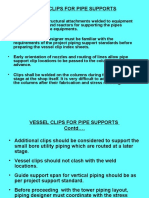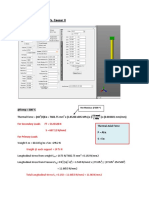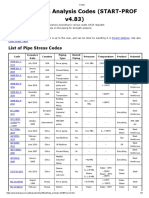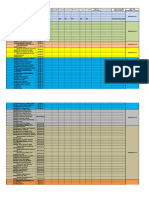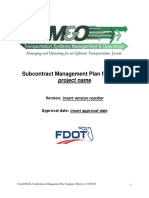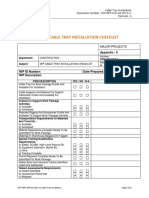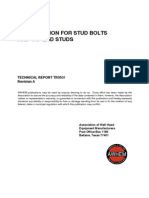100%(2)100% found this document useful (2 votes)
2K viewsRichmond Stress Notes
Richmond Stress Notes
Uploaded by
msaad2Piping stress analysis. Is to assure safety against failure of the piping system, prevent overloading of associated structural elements and terminal. Equipment. The prime factors are internal pressure and thermal strain. In order to deal with thermal strain some understanding of piping ileXlbUizy and the resolution of the. Forces moments and stresses must be known.
Copyright:
Attribution Non-Commercial (BY-NC)
Available Formats
Download as PDF, TXT or read online from Scribd
Richmond Stress Notes
Richmond Stress Notes
Uploaded by
msaad2100%(2)100% found this document useful (2 votes)
2K views110 pagesPiping stress analysis. Is to assure safety against failure of the piping system, prevent overloading of associated structural elements and terminal. Equipment. The prime factors are internal pressure and thermal strain. In order to deal with thermal strain some understanding of piping ileXlbUizy and the resolution of the. Forces moments and stresses must be known.
Copyright
© Attribution Non-Commercial (BY-NC)
Available Formats
PDF, TXT or read online from Scribd
Share this document
Did you find this document useful?
Is this content inappropriate?
Piping stress analysis. Is to assure safety against failure of the piping system, prevent overloading of associated structural elements and terminal. Equipment. The prime factors are internal pressure and thermal strain. In order to deal with thermal strain some understanding of piping ileXlbUizy and the resolution of the. Forces moments and stresses must be known.
Copyright:
Attribution Non-Commercial (BY-NC)
Available Formats
Download as PDF, TXT or read online from Scribd
Download as pdf or txt
100%(2)100% found this document useful (2 votes)
2K views110 pagesRichmond Stress Notes
Richmond Stress Notes
Uploaded by
msaad2Piping stress analysis. Is to assure safety against failure of the piping system, prevent overloading of associated structural elements and terminal. Equipment. The prime factors are internal pressure and thermal strain. In order to deal with thermal strain some understanding of piping ileXlbUizy and the resolution of the. Forces moments and stresses must be known.
Copyright:
Attribution Non-Commercial (BY-NC)
Available Formats
Download as PDF, TXT or read online from Scribd
Download as pdf or txt
You are on page 1of 110
INTRODUCTION
The objective piping stress analysis is to assure safety against failure of the piping
system, prevent overloading of associated structural elements and terminal equipment
from both intemal and external factors that would apply strain or forces to the system.
This to be undertaken with the best economic considerations.
The prime factors are internal pressure and thermal strain. In order to deal with
strain some understanding of piping Ny and the resolution of the forces
‘moments and stresses must be known.
Before delving into the complexities of piping flexibility for thermal strain it is worth
considering other factors that could prejudice the integrity of a piping system.
‘But the first consideration that must be undertaken will be the calculation for the wall
thickness of the pipework.
‘There are three significant documents at the start of a project, the P & I D, the Line
list and the Pipe Spec.
‘The engineer responsible for the Pipe Spec must calculate and seiect suitable wall
thicknesses for the pipes listed on the other two documents.
‘These thicknesses will determine the weight of the pipe, its stifness and are a key
factor in the determination of the stresses as will be shown later.
Pressure stress
‘The three principle factors are
(a) Temperature of the fluid conveyed in the pipework. ( see line list)
From this an allowable stress for the pipe material can be determined
(see piping code of practice)
(b) The pressure of the fluid conveyed in the pipework. (see ine list)
and P &1D)
(©) The size of the pipework (see line ii
Alll piping wall thickness calculations are based on the thin wall cylinder formulae
which are an approximation of the thick wall formulae.
Derivation of Hoop Stress from first principles
Load=pxd
— ee”
Stress = Load / Area i
=pd/2t 4 4
Derivation of longitudinal Stress from first principles
Load =p x {xx (@)/ 4} x
sae = sxdxt f Is
Stress = Load / Area it
= pdfat wi
As can be seen above the hoop stress is twice that of the longitudinal stress for the
same pressure and diameter. This has significant influence on design as can be seen
later.
‘Therefore the hoop stress is the maximum stress.
Therefore wali thickness calculations will always be based on the Hoop stress
formulae Tor all he codes of practice that we are going to consider.
oem TEATS ne
At this point it can be seen that at the max. pressure the stresses from
pressure are only half the allowable stress. This permits Stresses from factors like
deadweight bending to be up to half the allowable stress.
Example ; Pipe nom dia = 350 (14"), actual outside dia. 356mm
temp. = 200°C (392°F), pressure 10 bar approx. 1 n/mm*
Material API SL Grade B
From Table A-1 we can see that the allowable stress is 20.0 kpsi as this is an
Ameriacan code we must divide by 0.145 to bring it to n/mm? = 138 nimm*
Max stress = p.d /2t_ from which t= p.d/2 x (Max stress)
¥
1x 356/2x 138
4
13mm
Let us consider a weld joint factor (see table 302.3.4)
For API SL see a factor of 0.95
From which the min wall thickness will be 1.3 / 0.95 = 1.37 mm
If we add in an allowance for corrosion, say 1.6 mm we get a min. thiékness of
137+ 1.6= 2.97 mm
Should the manufacturing allowance be -12.5% then the min thickness will be
2.97/ 0.875 = 3.39 mm
It is probable that the piping engineer will select a wall thickness of
availability and general mechanical strength.
We are aware that Temperature and Pressure are the significant factors governing the
stresses created in piping systems.
‘There are others however which should be considered also and which will be #
problem from time to time:
‘These other influences for stress are
Vacuum Nozzle movement Self weight
Wind load Settlement Contents weight
Wave Load Insulation weight
RV forces
Earthquake
‘The factors listed above can be divided into two distinct forms as follows
Self Limiting Stress. - Generated by Deflection (Generally thermal)
You might also like
- Fidic Letters by ContractorDocument77 pagesFidic Letters by ContractorMajid Hassen83% (54)
- Piping Interview QuestionsDocument22 pagesPiping Interview Questionsmsaad289% (37)
- Plant Commissioning Start Up ProcedureDocument100 pagesPlant Commissioning Start Up Proceduremsaad292% (131)
- MCAA - Management Methods Manual PDFDocument818 pagesMCAA - Management Methods Manual PDFpatrickcarvalho6dfNo ratings yet
- Flare Line Stress AnalysisDocument7 pagesFlare Line Stress Analysisdhurjatibhutesh100% (1)
- Module 05 Piping Stress Analysis Pravin JedheDocument15 pagesModule 05 Piping Stress Analysis Pravin JedheAbdul Tayyeb100% (2)
- Piping Check ListDocument6 pagesPiping Check ListSajir ThiyamNo ratings yet
- Piping Training CourseDocument411 pagesPiping Training Coursemsaad2100% (15)
- Pipe Stress AnalysisDocument15 pagesPipe Stress Analysispvmsson100% (1)
- CAESARII Output WebinarDocument43 pagesCAESARII Output WebinarAnkith100% (1)
- StressDocument158 pagesStressSapana Malla100% (1)
- Piping Stress Analysis Is The Most Important Activity in Piping DesignDocument10 pagesPiping Stress Analysis Is The Most Important Activity in Piping DesignShreesanth SreenivasanNo ratings yet
- Vessel Clips For Pipe Supports: - Vessel Clips Are Structural Attachments Welded To EquipmentDocument10 pagesVessel Clips For Pipe Supports: - Vessel Clips Are Structural Attachments Welded To EquipmentshaliniNo ratings yet
- Selection Criteria For Lines Subject To Comprehensive Stress AnalysisDocument10 pagesSelection Criteria For Lines Subject To Comprehensive Stress AnalysisNithin Zs100% (1)
- Kursus Piping - Proejct and Type of ProjectDocument26 pagesKursus Piping - Proejct and Type of ProjectMohamad Afiq Amiruddin ParnonNo ratings yet
- Ower Iping: Charles Becht IVDocument52 pagesOwer Iping: Charles Becht IVmiguel medina100% (1)
- Distillation Column Nozzle Location Guidelines PDFDocument21 pagesDistillation Column Nozzle Location Guidelines PDFShyam MurugesanNo ratings yet
- Step by Step Methods For WRC 107 and WRC 297 Checking in Caesar IIDocument13 pagesStep by Step Methods For WRC 107 and WRC 297 Checking in Caesar IIMiguel Dominguez100% (1)
- Pipeline Stress Analysis With Caesar IIDocument16 pagesPipeline Stress Analysis With Caesar IISharbel Wg100% (1)
- Piping Stress Analysis TrainingDocument3 pagesPiping Stress Analysis TrainingGodwin100% (1)
- Pipeline Virtual AnchorDocument15 pagesPipeline Virtual Anchormaninventor100% (1)
- Flare Piping Stress NalysisDocument7 pagesFlare Piping Stress Nalysisgpskumar22100% (1)
- Points Which Should Be Incorporated While Making Flexibility SpecificationDocument2 pagesPoints Which Should Be Incorporated While Making Flexibility SpecificationtiwanasandyNo ratings yet
- Introduction To Piping Material ActivitiesDocument23 pagesIntroduction To Piping Material Activitiesvikas2510100% (1)
- Example From Theory To Caesar II PDFDocument12 pagesExample From Theory To Caesar II PDFIskandar Hasibuan100% (1)
- PIPINGDocument6 pagesPIPINGMananNo ratings yet
- How Do You Select Piping Materials Part 2 1711297806Document39 pagesHow Do You Select Piping Materials Part 2 1711297806Umair AnsariNo ratings yet
- Stress QuizDocument8 pagesStress QuizNagarjuna Seella100% (1)
- CAESAR II Software BasicsDocument28 pagesCAESAR II Software Basicsanishsr100% (1)
- CEASAR and PDMS SoftwareDocument10 pagesCEASAR and PDMS Softwarehayatmdazhar100% (1)
- Column Piping - Study Layout, Nozzle Orientation & Platforms RequirementsDocument23 pagesColumn Piping - Study Layout, Nozzle Orientation & Platforms Requirementsarfat nadaf100% (2)
- Alignment Check Methodology in Piping Stress Analysis Using Caesar IIDocument2 pagesAlignment Check Methodology in Piping Stress Analysis Using Caesar IIYoesbar Sofyan100% (1)
- Pipe Support Systems (2 PDH) Course No. M-2018Document17 pagesPipe Support Systems (2 PDH) Course No. M-2018arsssyNo ratings yet
- New Why To Use A Spring SupportDocument9 pagesNew Why To Use A Spring SupportAmarKumarNo ratings yet
- Load Cases For Typical Piping System Using CAESAR IIDocument4 pagesLoad Cases For Typical Piping System Using CAESAR IIsj22100% (1)
- Pipe Stress Codes Start-Prof 4.83r4 User's GuideDocument4 pagesPipe Stress Codes Start-Prof 4.83r4 User's Guideamit100% (1)
- Expansion Loop IDocument50 pagesExpansion Loop IDar Fall100% (1)
- Piping Designers Vessel OrientationDocument13 pagesPiping Designers Vessel Orientationkazishidota100% (1)
- PVE Piping Layout Presentation - Part 1Document68 pagesPVE Piping Layout Presentation - Part 1Nguyen Quang Nghia100% (1)
- Basics of Equivalent Static or Dynamic AnalysisDocument8 pagesBasics of Equivalent Static or Dynamic AnalysisSaikat Das Gupta100% (1)
- Buried Pipe - Neven DrobnjakDocument9 pagesBuried Pipe - Neven DrobnjakAnjani PrabhakarNo ratings yet
- Pipe FactsDocument30 pagesPipe FactsMekhmanNo ratings yet
- Mechanical Engineering Drawing: SR KaleDocument22 pagesMechanical Engineering Drawing: SR KaleAdnan RanaNo ratings yet
- ES 5 06 0019 - Flange Bolting GuidelinesDocument12 pagesES 5 06 0019 - Flange Bolting Guidelinessam.trags100% (1)
- 01 E02STB007-W146693-03-0 - BC - Stress UpdateDocument1 page01 E02STB007-W146693-03-0 - BC - Stress Update86tejas100% (1)
- Bourdon Effect in CAESAR II: Intergraph CASDocument3 pagesBourdon Effect in CAESAR II: Intergraph CASAnonymous Iev5ggSR100% (2)
- The Art of Designing Pipe Support SystemsDocument6 pagesThe Art of Designing Pipe Support Systemsguluu100% (1)
- 347 Stainless Steel Class 2500 Piping SpecificationDocument3 pages347 Stainless Steel Class 2500 Piping SpecificationTrevor Kanode100% (1)
- Jacketed Piping Stress Analysis 1681811585Document28 pagesJacketed Piping Stress Analysis 1681811585AliNo ratings yet
- Ipebs 31 CourseDocument9 pagesIpebs 31 Coursevenky2hemaNo ratings yet
- Definitions - Piping NotesDocument4 pagesDefinitions - Piping NotesMridul Das100% (1)
- CAESAR Load CaseDocument15 pagesCAESAR Load Casevijayanmks100% (2)
- Basics of Piping EngineeringDocument2 pagesBasics of Piping EngineeringSharjeel Aslam FaizNo ratings yet
- Piping Stress SpecificationDocument23 pagesPiping Stress Specificationpourang1361100% (1)
- Flange Leakage CheckDocument5 pagesFlange Leakage CheckKumar R100% (1)
- 19 Equipment and Piping LayoutDocument39 pages19 Equipment and Piping LayoutShaik SameeruddinNo ratings yet
- Zinq - AnalysisDocument116 pagesZinq - AnalysisAimiNo ratings yet
- Richmond Stress NotesDocument110 pagesRichmond Stress Notessateesh chand100% (2)
- Thin-Walled Pressure VesselsDocument43 pagesThin-Walled Pressure VesselsAdonis C. BibatNo ratings yet
- Stress ElbowsDocument8 pagesStress Elbowssanjeettirkey0% (1)
- Study Note - Failure TheoriesDocument9 pagesStudy Note - Failure TheoriesSboniso KhethukuthulaNo ratings yet
- Piping Stress Analysis For PROCESSDocument6 pagesPiping Stress Analysis For PROCESSFredie Unabia100% (1)
- Extracted Page From Stress B4Document3 pagesExtracted Page From Stress B4NaNo ratings yet
- Binder CreepDocument29 pagesBinder CreepettypasewangNo ratings yet
- Pipe Stress AnalysisDocument10 pagesPipe Stress AnalysisilayarasanNo ratings yet
- Subcontractor ESH Program G01 GHE 00001 2015 FinalDocument73 pagesSubcontractor ESH Program G01 GHE 00001 2015 FinalottisacNo ratings yet
- Building Responsibility MatrixDocument4 pagesBuilding Responsibility Matrixmsaad2No ratings yet
- Subcontract Management Plan TemplateDocument9 pagesSubcontract Management Plan Templatemsaad2100% (1)
- Welding GuidelinesDocument8 pagesWelding Guidelinesarunraj002100% (1)
- Iwp Piping Checklist: Appendix - 5Document3 pagesIwp Piping Checklist: Appendix - 5msaad2No ratings yet
- COP WFP CHK 01 2013 v1 All ChecklistsDocument47 pagesCOP WFP CHK 01 2013 v1 All Checklistsmsaad2100% (1)
- Army WeldingDocument757 pagesArmy WeldingKenn FerroNo ratings yet
- Work Breakdown Structure GuideDocument12 pagesWork Breakdown Structure Guidemsaad2No ratings yet
- Welding SymbolsDocument17 pagesWelding Symbolsarun.25509643No ratings yet
- A Piping TutorialDocument43 pagesA Piping TutorialIsmail_Iskeel__1082No ratings yet
- Project Review ChecklistDocument21 pagesProject Review Checklistmsaad2100% (2)
- Heat ExchangerDocument155 pagesHeat ExchangerSajilal JosephNo ratings yet
- Welding SymbolsDocument26 pagesWelding Symbolssamy7354No ratings yet
- WeldingDocument4 pagesWeldingirfanjdNo ratings yet
- Storage Tank Basic Training Rev 2Document97 pagesStorage Tank Basic Training Rev 2msaad290% (10)
- Process Plant Piping OverviewDocument133 pagesProcess Plant Piping Overviewskdalalsin100% (8)
- Pipe Fittings and Piping AuxiliariesDocument38 pagesPipe Fittings and Piping Auxiliariesmsaad2No ratings yet
- Recommendation For Interchangeable Stud Bolts Ad Tap End Studs, AWHEMDocument12 pagesRecommendation For Interchangeable Stud Bolts Ad Tap End Studs, AWHEMJeroen VisserNo ratings yet
- Process Plant Piping OverviewDocument133 pagesProcess Plant Piping Overviewskdalalsin100% (8)
- Practical Piping CurseDocument46 pagesPractical Piping Cursemsaad2100% (1)
- Basic of PipingDocument64 pagesBasic of Pipingparameswaran shivakumar96% (46)
- Piping Inspection HandbookDocument26 pagesPiping Inspection HandbookMdsr Hasan100% (2)
- Piping Inspection HandbookDocument26 pagesPiping Inspection HandbookMdsr Hasan100% (2)

